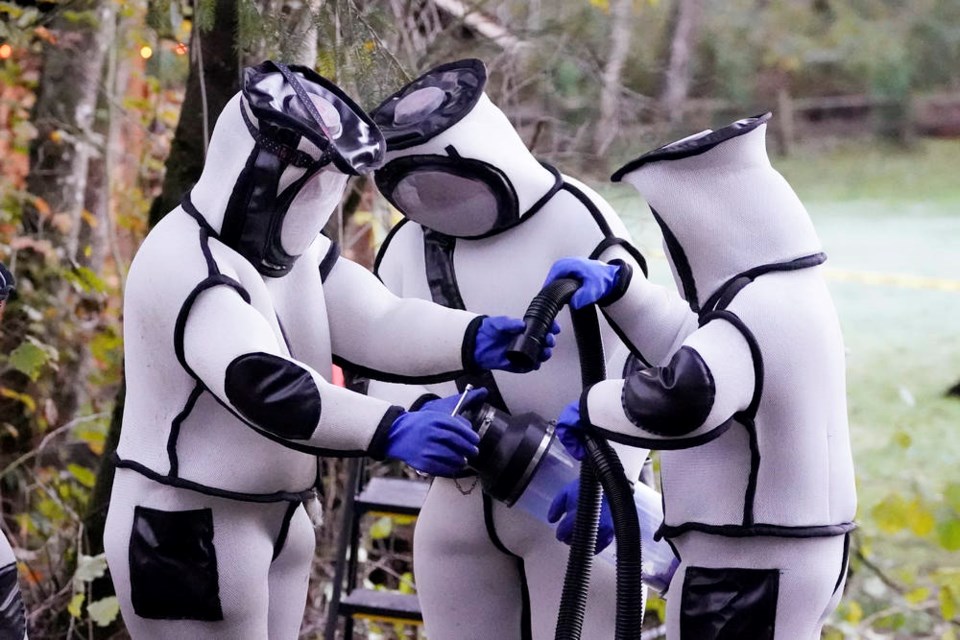There are stark differences in how Washington state authorities tracked down and eradicated the nest of Asian giant hornets last weekend, and how a group of beekeepers from Nanaimo knocked off the first of the so-called “murder” hornets a year ago.
“They had a SWAT team. It worked,” said Moufida Holubeshen. “We had snow suits. It worked, too.”
Holubeshen and husband, John, were part of a team that killed and collected samples in a Nanaimo park — the first nest of the hornets discovered the Americas.
Officials in Washington attached radio-tracking devices to trapped hornets in the hopes one would lead them to a nest. It worked: They found it in a tree on private property in Blaine, near the Canadian border.
Over the weekend, scientists in protective suits impervious to the hornet’s long stinger and face shields to protect against its spitting venom used an industrial vacuum to collect 98 hornets.
The Nanaimo group’s plan a year ago wasn’t as complicated. They used some good detective work, rudimentary tools and protective gear, clearing out a nest of 150 hornets, a queen and about 600 larvae after a chance discovery in Robins Park in south Nanaimo.
A nearby beekeeper had reported seeing two of the hornets about a month earlier around his hives, but there was skepticism, said John Holubeshen.
So local beekeepers did research with provincial apiculturist Paul van Westendorp and bee specialist Conrad Berube and got on Google Maps to look for areas the hornets would consider favourable nesting places.
By late afternoon on Sept. 19, 2019, the Holubeshens, Berube and Peter Lange had narrowed the area down to a corner of Robins Park in the Harewood neighbourhood.
John Holubeshen saw a few of the hornets flying overhead, and then suddenly got stung in the middle of his chest.
Hornets could be seen flying in and out of a hole in the ground about the size of a tennis ball, just a few metres away.
With night falling, it was determined the nest should be addressed immediately because new queens usually emerge in the fall on sunny days, Moufida Holubeshen said.
By 7:30 p.m., Berube started pumping the nest with carbon dioxide from a fire extinguisher used for electrical fires — the same device used by Washington officials.
They used shovels and gloved hands to dig out the hive, which John Holubeshen said was about the size of a large watermelon. Berube was stung seven times, describing the feeling as “red-hot thumb tacks” being pushed into his flesh.
Four Nanaimo specimens were shared with U.S. officials, Washington state managing entomologist Sven Spichiger said in a conference call Monday.
He said Washington is working closely with van Westendorp and Berube and other B.C. authorities. “British Columbia has traps all along the border and we are sharing all data,” he said.
Spichiger said the weekend eradication went “very smoothly.” The operation, however, failed to capture the queen hornet.
Entomologists will try to determine whether the nest had begun to produce new queens, and if any escaped to start new hives.
Officials suspect there are more nests on both sides of the border.
John Holubeshen said there have been no confirmed sightings of the giant hornet in Nanaimo since last year, though people have been extra vigilant about reporting any insect that seems out of the ordinary.
Asian giant hornets — which are about five centimetres long — are the world’s largest hornet and a predator of honeybees, already under siege from mites, diseases, pesticides and loss of food. A small group of Asian giant hornets can kill an entire honeybee hive in a matter of hours.
They can also deliver painful stings and spray venom, which is why those eradicating the nest in Washington were wearing face shields.



